Ontario is on a mission to rebuild its economy. For too long, Ontario has had an infrastructure deficit and the time to rebuild is now. The government is leading the way to get new roads and highways built, while supporting the largest transit expansion in North America. Ontario was left behind with over 300,000 manufacturing jobs lost between the sector’s peak in 2004 and 2018. Over the last three years, Ontario has created more jobs than ever before.
Rebuilding Ontario’s Economy
Despite a challenging economic situation that is having an impact on the province’s finances, the government has a plan to rebuild the economy. Companies are investing to start and grow their businesses, creating better jobs and bigger paycheques for workers across the province. Historic new investments are being made here across the electric vehicle supply chain, with Ontario soon to be host to the first electric vehicle battery plants in Canada. The future for these companies and other businesses across Ontario will be powered by the province’s clean electricity grid, including nuclear energy, and critical minerals from the North. The government is helping to bring back manufacturing jobs to Ontario.
The government is continuing to rebuild Ontario’s economy by attracting domestic and international manufacturing investments, expanding the province’s electricity capacity, supporting innovation, and helping small businesses thrive. This plan will support economic growth here in Ontario, creating stronger communities for the future, and improving Ontario’s productivity growth and creating prosperity for generations to come. The government will continue working to rebuild the economy and support good-paying jobs.

Strengthening Manufacturing and Attracting Investment
Ontario’s manufacturing sector is a significant driver of the provincial economy, representing 11.5 per cent of Ontario’s total GDP in 2022. Over the first three quarters of 2023, Ontario’s manufacturing sector added $1.9 billion in real GDP compared to the same period in 2022. In 2023, manufacturing employed 808,000 workers in the province, an increase of 20,900 from the previous year.
This recent progress comes after two decades where the sector was negatively impacted by the rising cost of doing business in Ontario, and market share was lost to countries with more productive firms and more competitive labour markets.1 By 2018, Ontario had lost over 300,000 manufacturing jobs from the sector’s peak in 2004.
This is why Ontario’s Plan to Build is continuing to help build a world-class manufacturing sector by attracting and supporting important investments in the province.
Helping Manufacturers Invest More in Their Businesses
As part of the 2023 Budget, the government announced the Ontario Made Manufacturing Investment Tax Credit — a 10 per cent refundable corporate income tax credit for eligible investments in buildings, machinery and equipment for use in manufacturing or processing in the province. The credit is available to claim for qualifying corporations and provides up to $2 million per year for eligible investments.
Over the first four years of the incentive, from 2023–24 to 2026–27, the credit will provide Ontario businesses with estimated income tax relief of approximately $1.1 billion. By lowering costs for Ontario manufacturers, the government is helping local manufacturing companies invest and expand, so the products of the future get made right here in Ontario by Ontario workers.
Supporting Small and Medium-Sized Businesses Through the Regional Development Program’s Advanced Manufacturing and Innovation Competitiveness Stream
As manufacturers faced challenges from growing international competition and supply chain disruptions, the government acted by launching the $40 million Advanced Manufacturing and Innovation Competitiveness (AMIC) Stream in January 2022, under the Regional Development Program. This stream provides funding support to advanced manufacturers provincewide, including those in the automotive, aerospace, chemical, life sciences and steel sectors,with a focus on small and medium-sized enterprises. It also provides access to a range of complementary services and supports, including advisory services that help these businesses navigate other government programs.
To continue to create an environment that attracts investments to help grow the manufacturing sector, the government is providing additional funds to enhance the AMIC Stream. This will support current program demand by providing more firms with the financial support and tools needed to improve competitiveness and productivity while reinforcing essential supply chains.
Building a World-Leading Electric Vehicle and Battery Supply Chain
The existing vehicle assembly and automotive parts production industries in Ontario directly support nearly 100,000 workers, as well as hundreds of thousands of indirect jobs throughout the auto supply chain, including over 700 parts firms as well as over 500 tool, die and mould makers.
The government has taken meaningful action to help rebuild Ontario’s automotive sector, revitalize manufacturing in the province and position the sector for success. Right here in Ontario, manufacturers are making new investments across the emerging electric vehicle (EV) supply chain to help the province become a North American hub for building the cars of the future and create more good-paying jobs. In 2023, Ontario was responsible for shipping 90.8 per cent of Canada’s international exports of automobiles and parts, with 96.4 per cent of these going to the United States. It is essential that the federal and Ontario governments work together to protect access to the market in the United States.
Over the last three years, Ontario has attracted more than $28 billion in transformative automotive and EV battery‐related investments from global automakers, parts suppliers, and EV battery and materials manufacturers, which are expected to create more than 12,000 new jobs. By supporting these investments, the government is helping to build Ontario’s end-to-end EV supply chain to position the province as a global player in this emerging industry. Recent significant EV supply chain investments have been made in EV production, batteries and battery components, as well as EV parts.
Electric Vehicle Production
- General Motors of Canada is investing more than $2 billion on multiple projects, including transforming the company’s Ingersoll CAMI Assembly manufacturing plant to deliver its all‐electric commercial vehicle brand BrightDrop. The new facility at its CAMI Assembly in Ingersoll will begin building battery modules in the second quarter of 2024, after converting the plant from traditional vehicle manufacturing to all-electric commercial delivery vehicle production.
- Ford Motor Company is investing $1.8 billion in its Oakville Assembly Complex to transform it into a high-volume hub of EV manufacturing, with the first EVs expected to be produced in 2025. The plant directly employs over 3,000 people and will be modernized with a flexible manufacturing system able to accommodate multiple battery electric vehicle models, including the installation of a battery pack assembly line.
Batteries and Battery Components
- Volkswagen is creating 3,000 jobs and investing $7 billion to establish its first overseas EV battery cell manufacturing plant in St. Thomas, Ontario. The plant will be completed in 2027 and produce battery cells for up to one million EVs per year.
- Stellantis N.V. and LG Energy Solution are partnering to support an estimated 2,500 jobs and invest more than $5 billion towards the NextStar Energy EV battery manufacturing plant in Windsor. The plant is expected to be fully operational in 2025 and would be the first large-scale, domestic, EV battery manufacturing facility in Canada.
- Umicore plans to create 600 new direct jobs and invest more than $2.7 billion to build North America’s first industrial-scale cathode and precursor materials plant in Loyalist Township. In the project’s first stage, the company will create these new direct jobs, in addition to 700 co-op positions for students that will be created throughout the project, making Umicore one of the largest private employers in Eastern Ontario.
Electric Vehicle Parts
- Magna International is adding more than 1,000 jobs and investing $471 million, supporting the opening of a new EV battery enclosure facility in Brampton, while also expanding its existing automotive manufacturing facilities in five other cities in the province: Guelph, Windsor, Belleville, Newmarket and Penetanguishene.
- Mitsui High-tec (Canada) Inc. is supporting 104 highly skilled jobs and investing $102.3 million to open a new manufacturing facility in Brantford to increase production of motor cores, the basic structure of the motor used in EVs.
- Dana Canada Corporation, a leading manufacturer in drivetrain and electric propulsion motor systems, is creating 105 jobs in its two facilities in Oakville and Cambridge, and investing approximately $60 million to expand its manufacturing capacity of thermal management systems, a key component for EV batteries and electronics.
- Bobaek America Inc. is creating 144 new jobs and investing $35 million to build a new manufacturing facility in Windsor, specializing in battery insulation panels and cell sheets for EVs. The new manufacturing facility is expected to open in June 2024.

Attracting Investments Through Invest Ontario
Invest Ontario was established in July 2020 to help attract investments from around the world and support businesses to expand their operations here in the province. The agency serves as a one‐stop source to investors for business information and tailored investment solutions. It provides facilitated access to all levels of government and local service providers, as well as financial assistance through the Invest Ontario Fund. To date, Invest Ontario has helped secure $2.4 billion in investments, which are expected to create 2,600 new jobs, with many more opportunities in the pipeline.
To continue attracting major investments to Ontario, the government is allocating an additional $100 million to the Invest Ontario Fund. This builds on the $100 million announced in the 2023 Ontario Economic Outlook and Fiscal Review, and brings the fund total to $600 million. The enhanced fund will allow the agency to attract more strategic investments that create good-paying jobs, encourage innovation and support stronger supply chains in strategic sectors where the province has a global competitive advantage, including advanced manufacturing, life sciences and technology.
Boosting Ontario’s Shipbuilding Industry
Ontario’s shipbuilding and repair industry supports the movement of people and goods across the province, while promoting safety and security. In 2022, Ontario’s shipbuilding and boatbuilding industry contributed over $50 million to the economy. As part of the government’s plan to support the marine sector, Ontario is moving forward with the development of a grant program that will help boost the economic competitiveness of the province’s shipbuilding industry. This will help elevate Ontario’s shipbuilding industry to compete with other parts of the country for key procurements. The government is engaging with the industry on the development of this new program to ensure it remains competitive, creates jobs and helps grow Ontario’s economy.
Leveraging Northern Ontario’s Natural Resources
Through Ontario’s Critical Minerals Strategy, the government is working with Indigenous communities to unlock the economic potential of the province’s critical minerals in the North, including in the Ring of Fire. The government is also supporting Northern Ontario through the Sustainable Growth: Ontario’s Forest Sector Strategy, which sets out to encourage economic growth in the forestry industry, supporting Indigenous, Northern and rural communities that depend on the sector while ensuring forests are managed sustainably.
Mining Value From Critical Minerals in Ontario
Developing Critical Infrastructure for the Ring of Fire
Developing Ontario’s Ring of Fire region is crucial to improving quality of life for those communities. The government is working together with its First Nations partners to increase prosperity and improve access to health care, high-speed internet and other services. The Ring of Fire region is a world‑class source of several critical minerals, including chromite, cobalt, nickel, copper and platinum. These all play a significant role in supporting innovative technologies for high‐growth sectors such as batteries, electronics, electric vehicles and cleantech. Building the necessary infrastructure in and around the region will be a prerequisite to unlocking and lowering the cost of mining projects in the Ring of Fire and creating better supply chain connections between resources, industries, workers and communities in Northern Ontario and the manufacturing sector in Southern Ontario.
Ontario has dedicated $1 billion to support critical legacy infrastructure such as all‐season roads, broadband connectivity and community supports for the Ring of Fire region. Currently, there are no all-season roads connecting the Ring of Fire to the provincial highway network. These roads would improve First Nations’ community access to goods and services, including education, health care and housing.
The government will continue to support the Environmental Assessments (EAs) for the Marten Falls Community Access Road Project, the Webequie Supply Road Project and the Northern Road Link Project, led by the Marten Falls First Nation and Webequie First Nation.
In March 2024, the Marten Falls First Nation and Webequie First Nation signed a Community Development Agreement with Ontario to develop community infrastructure projects that could support future economic development opportunities in the Ring of Fire area. The agreement commits Ontario to supporting shovel-ready infrastructure projects that could include the construction of health and training facilities, recreation centres, commercial buildings and labour force development programs. These projects would help improve the livelihood and well-being of the First Nation communities in the area. The agreement also commits Ontario and the two lead First Nations, Marten Falls and Webequie First Nations, to work together to make decisions about the construction, ownership and operation of the all-season road network, should the EAs be approved. This collaboration will accelerate project timelines and help ensure the communities are ready to participate in future economic development opportunities in the region.
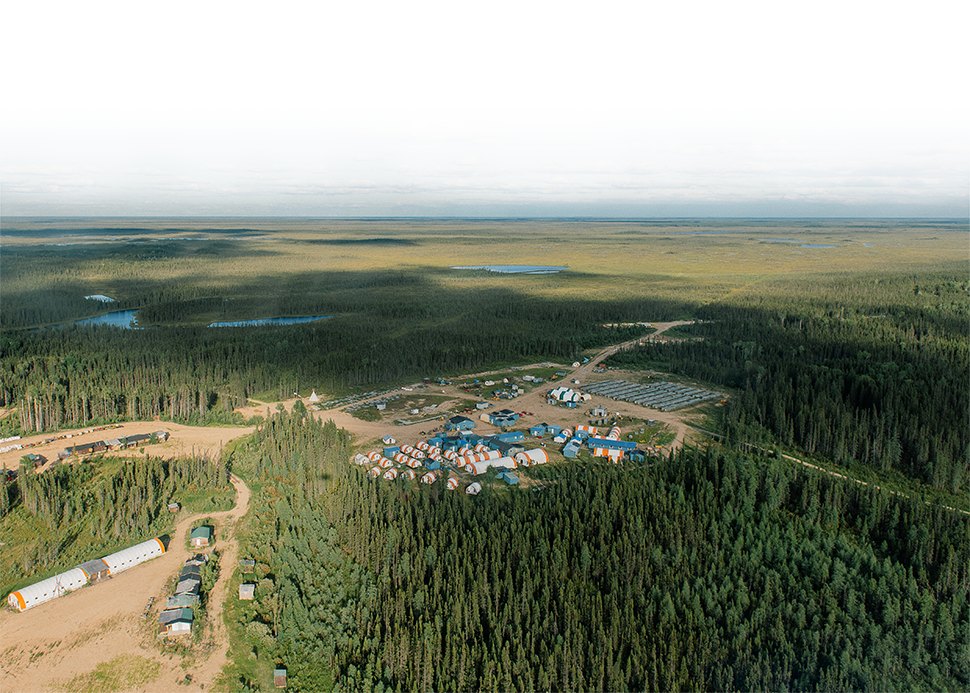
In addition to supporting these EAs, Ontario is also supporting the development of additional critical infrastructure to benefit Northern communities. This includes initiatives such as the Matawa First Nations Rapid Lynx broadband project to provide modern and scalable telecommunication services to five Matawa First Nations member communities: Nibinamik, Neskantaga, Eabametoong, Marten Falls and Webequie First Nations.
As Ontario invests in and makes progress on developing critical infrastructure in the Ring of Fire region, the provincial government continues to call on the Government of Canada to step up, match Ontario’s funding commitments, and expedite approval processes for all infrastructure that would enable the development of the Ring of Fire and bring considerable economic benefit to Indigenous and Northern communities.
Enhancing the Critical Minerals Innovation Fund
The mining industry has rapidly evolved into a high-tech industry, with innovative ideas such as adopting electric mobile mining equipment to replace the use of diesel equipment, or remote mining to help companies access resources in isolated areas. Research projects are needed to tackle problems such as mining at depth in existing mines, the successful extraction of minerals from mine wastes, and technology that supports the recycling of electric vehicle batteries.
In November 2022, Ontario launched the $5 million Critical Minerals Innovation Fund (CMIF) to support innovation and research projects in the critical minerals sector to help increase exploration, mining, development, production and processing of critical minerals in Ontario. These projects are expected to tackle strategic challenges faced by the critical minerals sector in several areas of focus, such as the battery supply chain, deep exploration and mining, mineral processing, as well as the recovery of minerals.
To further support critical minerals development in the province and the creation of Ontario-made intellectual property, the government is investing $15 million to enhance the CMIF. The additional funding of $5 million per year in 2024–25, 2025–26 and 2026–27 will continue to help Ontario’s mining sector undertake research, development and commercialization of innovative technologies, including techniques, processes and solutions related to critical minerals. Through this investment, the CMIF will encourage further private–public collaboration and help create jobs supporting municipalities, Indigenous communities and regional economies.
Improving Sustainability Through Ontario’s Forestry Sector
Ontario’s forest industry can derive significant economic benefits from the complete use of wood products including forest biomass — which includes bark, shavings and sawdust — along with low-grade trees.
To support the Forest Biomass Action Plan and the Sustainable Growth: Ontario’s Forest Sector Strategy, the government created the Forest Biomass Program in May 2023. This $19.6 million program helps develop the economic potential and environmental benefits offered by new and emerging uses of underutilized wood and mill by-products. Potential biomass products include medicine, bioplastics, 3D printing, mass timber products, biodiesel and biofuels.
Ontario is providing additional investments to extend the program over the next three years at an annual funding level of $20 million. The Forest Biomass Program helps support projects to harvest more wood from Crown forests for use in traditional and innovative products, to increase forest-sector job creation and promote regional economic growth. The program will also contribute to the second pillar of the Sustainable Growth: Ontario’s Forest Sector Strategy, Putting More Wood to Work, with the goal to harvest Ontario’s sustainable wood supply of 30 million cubic metres by 2030.
The Forest Biomass Program includes four streams:
- Indigenous Bioeconomy Partnerships Stream — Supporting Indigenous businesses and communities to become more active participants in the forest sector through the use of forest biomass.
- Exploring Biomass Pathways Stream — Improving and supporting for-profit, and not-for-profit feasibility, engineering and design studies.
- Innovative Bioproduct Manufacturing Stream — Focusing on projects that support commercialization of new and/or innovative uses of forest biomass.
- Modernization Stream — Supporting major modernization investments in foundational forestry facilities and/or establishment of new complementary businesses to consume large quantities of underutilized wood and biomass.
Powering Ontario’s Growth
To meet growing electricity demand, and as the government rebuilds Ontario’s economy, the province may need to double electricity capacity by 2050. Ontario’s clean electricity grid is a competitive advantage in attracting investments and jobs to the province. The government is continuing to invest in a clean energy future across the province. This is essential to compete and support the transition to a cleaner economy, as Ontario attracts investments in sectors such as manufacturing, mining, electric vehicles and batteries.
In July 2023, the government released Powering Ontario’s Growth: Ontario’s Plan for a Clean Energy Future. It is a pragmatic plan outlining the actions Ontario is taking to meet increasing electricity demand, which invests in the future of nuclear, while keeping costs down for people and businesses. The plan includes new zero-emissions electricity generation, storage and transmission lines that will provide families and industries with the reliable, low-cost and clean power they need, as well as power the province’s future. In the transition, natural gas-fired generation will continue to provide the province with the capacity to meet electricity demand and maintain system reliability.
Building on Ontario’s Nuclear Advantage
The government is leveraging the Ontario nuclear sector, a world leader in experience and expertise in this safe, reliable and clean energy source as a way to develop the next generation of nuclear power, including grid-scale small modular reactors (SMRs). Ontario’s nuclear advantage better positions the province to compete for international investments, which are increasingly prioritizing access to clean energy, as well as export development opportunities for Ontario’s nuclear sector. The government has also introduced the Ontario Sustainable Bond Framework, which includes financing for nuclear energy. The new framework allows Ontario to issue Green Bonds for umbrella projects that provide environmental benefits to the province. Projects under this framework include clean transportation, green buildings, clean energy such as emissions-free nuclear, climate change, energy efficiency, and forestry and agriculture initiatives, all of which support sustainability across Ontario.
Supporting Nuclear Refurbishments
Refurbishing the Pickering Nuclear Generating Station
The Ontario government is supporting the Ontario Power Generation (OPG) plan to proceed with the next steps towards refurbishing the Pickering Nuclear Generating Station B Units. OPG is proceeding with the project initiation phase, which includes engineering and design work, as well as securing long lead time components that can require years for manufacturing.
Ontario is following a multi-phase approvals process to ensure the Pickering Nuclear Generating Station refurbishment project only proceeds if it is in the best interests of Ontario and its ratepayers. The Pickering refurbishment is also subject to regulatory approval by the federal regulator, the Canadian Nuclear Safety Commission.
Once refurbished, the Pickering Nuclear Generating Station would produce a total of more than 2,000 emissions-free megawatts (MW) of electricity, equivalent to powering two million homes, helping to meet increasing demand from electrification and fuelling the province’s economic growth.
The Conference Board of Canada’s preliminary analysis estimates this refurbishment would increase Ontario’s GDP by $19.4 billion and create about 11,000 jobs over the 11-year project period. Post‑refurbishment operation of the facility would also create and sustain about 6,410 Ontario jobs per year for decades to come.
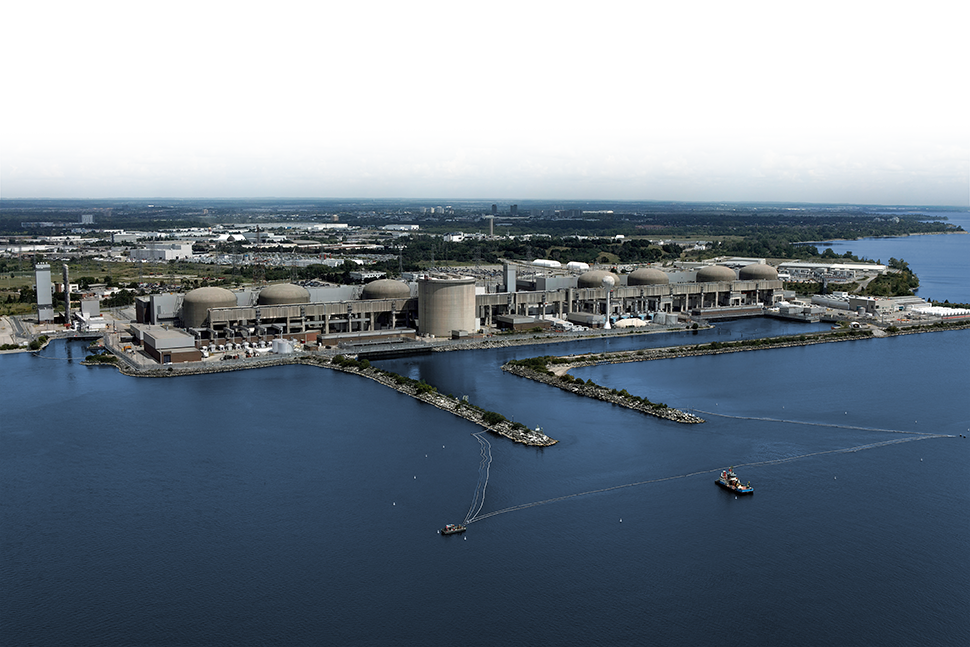
Refurbishing Darlington and Bruce Nuclear Generating Stations
Ontario continues to support the refurbishments at the Darlington and Bruce Nuclear Generating Stations, securing clean, reliable and affordable electricity for generations to come. The generating capacity of the stations, with refurbished units, will provide approximately 3,500 MW and 6,550 MW, respectively, which is approximately equivalent to the combined 2022 peak demand of Alectra Utilities (serving 17 communities, including Mississauga, Hamilton, Brampton, Vaughan, St. Catharines and Barrie), Toronto Hydro, and Oshawa Power and Utilities Corporation (Oshawa PUC Networks) Networks — in total, serving about 1.7 million residential customer accounts and 188,000 commercial, industrial and other customers, equivalent to about 36 per cent of the province’s electricity customers.
OPG has already completed refurbishment of two of the four Darlington units. Approximately 96 per cent of the Darlington Refurbishment Project costs are being spent in the province, involving more than 260 companies. According to a report by The Conference Board of Canada, the $12.8 billion Darlington Refurbishment Project, together with the nuclear station’s extended operation, will generate approximately $90 billion in economic benefits for Ontario, and increase employment by an average of 14,200 jobs per year across the province over an estimated 39-year operating period.
Building the Future of New Nuclear
As part of Powering Ontario’s Growth plan, the government is working with OPG to commence planning and licensing for three additional Small Modular Reactors (SMRs) at the Darlington Nuclear Generating Station site. This would bring Ontario’s total to four SMRs, which would produce enough clean electricity to power 1.2 million homes. OPG has commenced site preparation activities for the SMR project at Darlington.
The government is also working with Bruce Power on pre‐development work for the first large‐scale nuclear generation build in over three decades in Canada.
Growing Ontario’s Nuclear Supply Chain
Ontario’s expansion of nuclear energy is enhancing the province’s position as a global leader in new nuclear technologies, creating new export opportunities that will drive economic growth.
- Ontario is leveraging the expertise of OPG and its subsidiary Laurentis Energy Partners to support a new collaboration agreement with SaskPower to support SaskPower’s nuclear program management, project licensing and operational readiness.
- OPG and other Ontario nuclear supply chain providers have already signed major agreements valued at approximately $1 billion to export nuclear products and services to other countries, including Poland, Estonia and the Czech Republic.
Supporting Clean Energy Storage Projects
New energy storage projects will support the operation of Ontario’s clean electricity grid by drawing and storing electricity off-peak when power demand is low, and returning the power to the system at times of higher electricity demand. The procurement of a targeted 2,500 MW of clean energy storage represents the largest battery procurement in Canada’s history and will increase the efficiency of Ontario’s clean electricity grid, complementing Ontario’s 2023 agreement for the 250 MW Oneida Energy Storage Project.
Boosting the Electricity Grid with Clean Hydrogen
The Ontario government is investing in 15 new projects that will help integrate hydrogen into the province’s electricity grid. This funding is through the $15 million Hydrogen Innovation Fund, which supports projects that pave the way for reliable, affordable and clean electricity generation from hydrogen to help power the province’s growth.
Continuing to Support the Northern Economy
The Northern Energy Advantage Program (NEAP) provides a rebate for eligible mining, forestry and steel operations in Northern Ontario. NEAP helps eligible large industrial operators better manage electricity costs as well as create and sustain good jobs in Northern Ontario to maintain global competitiveness, with 28 facilities currently receiving benefits from NEAP. To provide for continuing support to eligible large facilities in the North, the government is increasing NEAP funding by an additional $86 million over three years, resulting in a total annual program amount of $167 million in 2024–25 and $206 million for 2025–26 and 2026–27.
Expanding Electricity Transmission Infrastructure in the North
Expanding electricity transmission infrastructure supports economic development opportunities and improves reliability in the North. For example, the East-West Tie transmission project, from Wawa to Thunder Bay, went into service in March 2022, improving transmission capacity and flexibility. The Wataynikaneyap Power Transmission Project is nearing completion and will connect 16 remote First Nation communities to Ontario’s clean electricity grid as they transition away from diesel electricity generation.
The Waasigan Transmission Line project is also under development between Shuniah (near Thunder Bay), to Atikokan and then to Dryden. It will support community, industrial and mining growth in the Northwest.
Additional new projects proposed in the coming years include three new transmission lines in Northeastern Ontario to support forecast electricity demand growth, such as in the Sault Ste. Marie and Timmins areas, including from the conversion from coal to electric arc furnaces at Algoma Steel as well as from growth in the mining sector.
Keeping Electricity Costs Down in Indigenous Communities
The Ontario government is supporting building more clean energy projects to reduce electricity costs in Indigenous communities. In November 2023, the government announced an increase of $5 million for the Independent Electricity System Operator (IESO) Indigenous Energy Support Programs, bringing the total annual investment up to $15 million. The IESO awarded funding for 93 projects from across 58 Indigenous communities in 2023, which will help promote Indigenous leadership in the electricity sector. These Indigenous Energy Support Programs help ensure that Indigenous communities can fully leverage opportunities in the electricity sector that can create significant, long-term economic benefits.
Reviewing Time-Limited Relief for the Electricity Distribution Sector
Under the Electricity Act, 1998, municipal electricity utilities (MEUs) are subject to a transfer tax of 33 per cent on the fair market value of electricity assets sold to the private sector. The government supports sector consolidation in an effort to improve services and convenience, improve reliability and security, cyber security and the adoption of new technology and consumer demands.
In the 2022 Budget, Ontario extended temporary tax relief measures related to the sale of assets until December 31, 2024. During this period, the transfer tax rate is reduced from 33 per cent to 22 per cent for larger MEUs, and the rate is reduced from 33 per cent to zero per cent for MEUs with fewer than 30,000 customers. In addition, any capital gains arising under the electricity payments in lieu of taxes (PILs) deemed disposition rules are exempt from any PILs.
In 2024, Ontario will review supports for consolidation of interested MEUs, and will provide a status update expected as part of the 2024 Ontario Economic Outlook and Fiscal Review, prior to the expiry of the existing relief measures.
Consolidation in the electricity distribution sector can help local distribution companies be better positioned to support Ontario’s electrification needs and improve services for customers well into the future.
Supporting Innovation and Economic Growth Through Research and Technology
Innovation is essential to Ontario’s long-term economic growth. Technological advancements and new approaches across all industries help drive innovation and progress, propelling Ontario towards a stronger, more resilient and productive economy for today and the future.
Strengthening Research and Development With Advanced Research Computing
Ontario’s advanced research computing (ARC) facilities help ensure researchers have the resources they need to make new discoveries and commercialize the innovations that benefit businesses, workers and families across the province. The Ontario government is investing an additional $18 million over the next three years to support the ongoing operation and maintenance of Ontario’s ARC systems located across the province and ensure the systems meet the storage and computational demands for research into technologies such as artificial intelligence (AI). In addition, the government is investing $47.4 million for the infrastructure refresh of aging ARC systems at the University of Toronto (the Niagara Supercomputer) and University of Waterloo (the Graham Supercomputer).
In 2022–23, ARC systems helped support over 6,000 Ontario researchers and 4,000 trainees. Over the last five years, investments have also supported the development of 338 patent applications, the launch of more than 250 technology startups, and 800 global collaborations. This investment will support advancements in critical fields such as life sciences, engineering, clean technologies, nuclear research, electric vehicles and quantum computing.
Keeping Costs Down for Ontario Businesses
The government has taken significant action to lower costs for businesses to help them compete, grow and weather today’s economic uncertainty. Ontario’s small businesses account for more than 97 per cent of all businesses in the province, helping to drive the economy and create good‐paying jobs for workers in growing communities across Ontario.
In 2024, the government would enable an estimated $8.0 billion in cost savings and support for Ontario businesses, of which $3.7 billion would go to small businesses. Some of the actions taken include:
- Implementing the Ontario Made Manufacturing Investment Tax Credit to help local manufacturers invest and expand, by lowering costs for eligible investments in buildings, machinery or equipment used in manufacturing or processing in the province;
- Temporarily cutting the gas tax by 5.7 cents per litre and the fuel tax by 5.3 cents per litre beginning July 1, 2022, which are proposed to be extended to December 31, 2024, to help reduce the cost of gas and fuel for Ontario businesses;
- Supporting cuts to Workplace Safety and Insurance Board (WSIB) premium rates without reducing benefits, leading to a reduction in payroll costs for businesses;
- Increasing the Employer Health Tax (EHT) exemption from $490,000 to $1 million. The EHT exemption increase helps businesses by reducing the tax for eligible private-sector employers on their total Ontario payroll;
- Cancelling the cap‐and‐trade carbon tax to remove its cost impact from items such as gasoline, diesel fuel and natural gas;
- Lowering high Business Education Tax (BET) rates, providing $450 million in annual savings for over 200,000 employers, or 95 per cent of all business properties in Ontario;
- Reducing the small business corporate income tax rate to 3.2 per cent and expanding access to this preferential rate, helping small businesses compete and thrive by lowering their costs;
- Implementing the Regional Opportunities Investment Tax Credit to support businesses that make investments and expand in regions of Ontario that have lagged in employment growth;
- Allowing businesses to accelerate writeoffs of capital investments for income tax purposes, to support businesses that make eligible investments across Ontario; and
- Implementing the Comprehensive Electricity Plan in January 2021, which is lowering electricity costs by an estimated average of 13 to 16 per cent in 2024 for medium‐size and larger industrial and commercial customers, respectively.

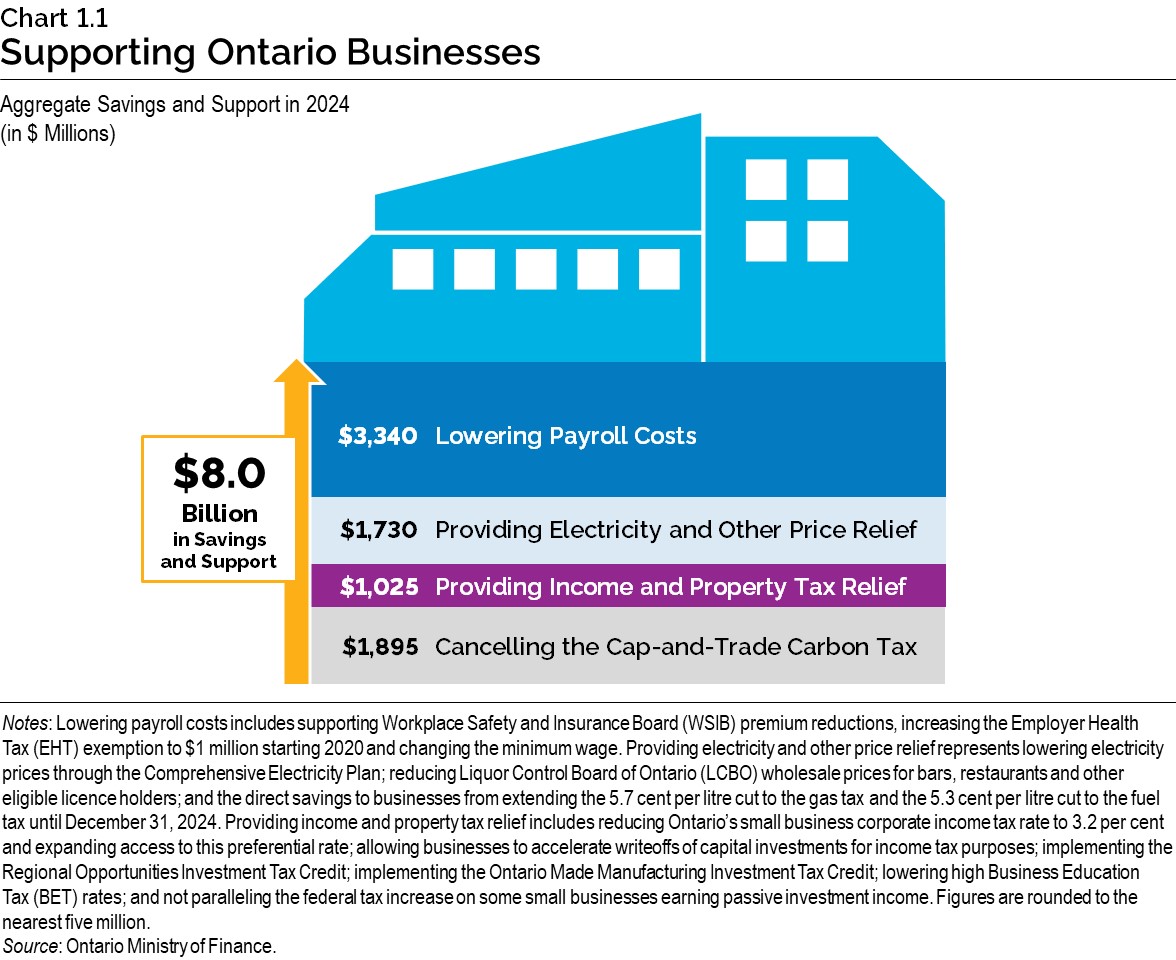
Helping Small Businesses Grow and Thrive
Small businesses and entrepreneurs are a critical part of Ontario’s plan to grow the economy. The government understands that small businesses face unique challenges and that a one-size-fits-all approach to business support may not be effective.
Ontario’s Small Business Enterprise Centres (SBECs) provide entrepreneurs with a full range of support services needed to start and successfully grow their small business. These centres are located across the province and provide one-stop access to advisors, programs and services, as well as learning opportunities for small business owners specific to their region, including:
- Financial support through microgrants for eligible entrepreneurs and students;
- Free consultations with a qualified business consultant;
- Internet and computer access for business research and planning;
- Review of business plans;
- Workshops and seminars; and
- Guidance on licences, permits, registration, regulations, and other documents required to start a business.
Ontario is investing an additional $6.8 million over the next two years to enhance the Starter Company Plus program and it is also providing additional support for Ontario entrepreneurs. The enhancement will allow more eligible entrepreneurs to receive a Starter Company Plus Grant of $5,000, and will provide grants to an additional 500 entrepreneurs over two years. Through the program, these entrepreneurs will receive training, mentoring and business advice.
In addition, this new funding will support the Summer Company program, which is delivered through the SBEC network. The program provides at least 12 hours of business training, one-on-one mentoring and grants up to $3,000 to Ontario students between the ages of 15 and 29 to start a full-time business over the summer. This additional funding will provide grants to an additional 250 students (15 to 29 years old) over two years. The Summer Company program has launched over 1,700 youth businesses over the last five years across Ontario.
The new funding will also help the Fédération des gens d’affaires francophones de l’Ontario (FGA) provide additional support to help Ontario’s Francophone entrepreneurs start and grow their business through dedicated advisory supports, workshops and events. Through this funding, Francophone entrepreneurs will be able to receive services in their preferred language.
Modernizing Capital Markets
The government continues to collaborate closely with key partners, including the Ontario Securities Commission (OSC) and the Canadian Investment Regulatory Organization (CIRO), to modernize Ontario’s capital markets and foster competition, innovation and economic growth while ensuring investor protection.
To support equitable access to capital markets, the government is actively supporting the OSC in engaging Indigenous partners to identify opportunities for increased participation of Indigenous businesses and communities in capital markets.
The Ontario government remains committed to promoting capital formation. This is why it continues to work with the OSC to establish a Long-Term Asset Fund (LTAF) framework to enhance both institutional and retail investor access to investment opportunities in capital-intensive assets such as infrastructure, natural resource projects, and other relatively less liquid assets.
In addition, to promote capital markets and facilitate investment in Ontario companies, the OSC has undertaken several priority initiatives. To encourage early-stage financing, the OSC is working to develop rules to support angel investor groups and broadening sources of capital by adopting a self-certified prospectus exemption. To support capital-raising for smaller issuers, the OSC is broadening investment dealer participation in prospectus offerings.
The government and the OSC continue to evaluate and implement, as appropriate, recommendations from the Capital Markets Modernization Taskforce as part of modernizing Ontario’s capital markets regulatory framework. To date, 21 recommendations from the Capital Markets Modernization Taskforce have been fully implemented, with an additional five recommendations anticipated to be implemented by 2025.
Supporting Ontario’s Film and Television Industry
Ontario’s vibrant and growing film and television industry continues to create high-value jobs and attract investment across the province. Productions that received support from provincial programs spent approximately $3.2 billion in Ontario in 2022, which contributed to over 45,000 full-time direct and spinoff jobs.2
As first announced in the 2022 Budget, the government is modernizing Ontario’s film and television tax credits to reflect the latest industry practices. Since 2022, the government has expanded tax credit eligibility to productions made available exclusively online, introduced a screen credit requirement, and expanded eligible expenditures for the Ontario Production Services Tax Credit to include location fees.
The government also committed to exploring opportunities to simplify tax credit support for computer animation and special effects activities. Based on feedback from industry consultations, the government is proposing new requirements for the Ontario Computer Animation and Special Effects Tax Credit to simplify eligibility and help companies get their tax credits faster, while also ensuring support remains targeted to professional productions.
Going forward, the government will review the Ontario Film and Television Tax Credit regional bonus to ensure it effectively supports film and television production across the province.
See the Annex: Details of Tax Measures and Other Legislative Initiatives for more information.
Our members unanimously support the government’s proposed changes to simplify the Ontario Computer Animation and Special Effects Tax Credit. These changes will help grow Ontario’s visual effects and animation companies and improve our industry’s competitiveness domestically and internationally.
Matt Bishop and Pete Denomme
Co-Chairs
Computer Animation Studios of Ontario (CASO)
Supporting Ontario’s Agriculture and Food Sector
The government recognizes the importance of the agriculture and food sector to the people of Ontario and to the provincial economy, as well as the challenging economic environment. Ontario will continue to work with the sector to manage the risks that it faces and to help grow the industry. In addition, in January 2024, the government announced the beginning of consultations to help inform the development of a new rural economic development strategy.
Building Infrastructure, Highways and Transit in Your Communities
Ontario is investing more than $190.2 billion over the next 10 years in highways, transit, broadband, housing-enabling and other infrastructure. This is the most ambitious capital plan in Ontario’s history, and is part of the government’s plan to build the infrastructure that communities and municipalities need to grow and prosper.
Funding Infrastructure to Build More Homes
To address Ontario’s housing crisis, the provincial government is working with other levels of government and industry partners to help build at least 1.5 million homes by 2031.
Introducing the New Municipal Housing Infrastructure Program
Building more homes is critical to rebuilding Ontario’s economy. Building homes requires housing-enabling infrastructure. This is why the government is investing $1 billion for the new Municipal Housing Infrastructure Program to largely support core infrastructure projects, such as roads and water infrastructure to enable housing for growing and developing communities.

Enhancing the Housing-Enabling Water Systems Fund
In January 2024, Ontario launched the three-year $200 million Housing-Enabling Water Systems Fund to help municipalities repair, rehabilitate and expand drinking water, wastewater and stormwater infrastructure. The government is quadrupling the Housing-Enabling Water Systems Fund to total $825 million so more funding can be available, through an application-based program, for municipal water infrastructure projects that would enable new housing.
Rewarding Municipalities with the Building Faster Fund
In August 2023, the government announced the Building Faster Fund, a three-year $1.2 billion fund to support municipalities that meet or exceed the housing targets they have pledged to achieve by 2031. The fund rewards municipalities that make significant progress against their targets by providing funding for housing-enabling and community-enabling infrastructure. Funding is provided to municipalities that have reached at least 80 per cent of their provincially assigned housing target for the year with increased funding for municipalities that exceed their target.
The Building Faster Fund also includes $120 million for small, rural and Northern communities that have not been assigned a housing target to support their unique needs and circumstances, following municipal consultations.
The government is giving municipalities the tools they need to build more homes faster, to tackle the affordability crisis that is pricing too many people, especially young families and newcomers, out of the dream of homeownership.
Ontario continues to call on the federal government to pay its fair share and help fund housing-enabling infrastructure investments. The provincial government will continue to work with municipalities as part of Ontario’s continuing commitment to help unlock housing opportunities and support growing communities.
Building Stronger Communities for Future Generations
Advancing the Plan to Build With the Building Ontario Fund
Ontario’s new infrastructure bank, the Building Ontario Fund, will support the financing and building of critical infrastructure projects across the province. As the government moves forward with Ontario’s Plan to Build, the fund will act as a tool to attract capital in order to help meet the infrastructure needs of a growing Ontario. The government has allocated an initial $3 billion to the fund.
Following its introduction in the 2023 Ontario Economic Outlook and Fiscal Review, the fund announced the appointment of its inaugural board of directors. The fund continues to make progress in laying the foundation for future success as it establishes a governance framework and builds out the organization, including recruitment of the chief executive officer.
The Building Ontario Fund is developing a detailed process to ensure there is appropriate criteria for selecting projects and partners in priority areas, including long-term care homes, energy infrastructure, affordable housing, municipal and community infrastructure and transportation. This includes support for infrastructure projects for Indigenous communities that advance community and economic well‐being. The fund is also creating opportunities for pension funds to put their members’ investments to work right here in Ontario.
The fund is also exploring opportunities to support large-scale projects in the postsecondary student housing, long-term care, energy generation and municipal infrastructure sectors. For example, the Building Ontario Fund is currently engaging with Canadian entities with long-term investment horizons and an Ontario-based postsecondary institution to help finance new student housing projects. The fund is also exploring opportunities with partners to finance additional long‑term care homes and major energy generation, including attracting investments to build new nuclear projects.
The Ontario government is proposing legislation to further support the Building Ontario Fund’s mandate and investment objectives as an independent, arm’s-length agency. The legislation, along with the government’s allocation of initial funding, would support the fund in making infrastructure investments and help deliver more infrastructure faster.
Introducing the Community Sport and Recreation Infrastructure Fund
Ontario is investing $200 million over three years in a new application-based local Community Sport and Recreation Infrastructure Fund, demonstrating the government’s commitment to provide children, families and seniors across Ontario with new and improved opportunities to participate in sport and recreational activities. The fund will support a growing population by investing in new and revitalized sport, recreation and community facilities for youth and families. Addressing the critical need for infrastructure support in the sport and recreation sectors will ensure that the people of Ontario can live, work and play in their local communities.
Doubling the Ontario Community Infrastructure Fund
The Ontario Community Infrastructure Fund continues to build community infrastructure and provides investments in asset management for 425 small, rural and Northern communities across the province. The government doubled its annual investment to nearly $2 billion over five years beginning in 2021–22 to help build and repair community infrastructure such as roads, bridges, water and wastewater infrastructure.

Table 1.1
Examples of Recently Approved and Completed Projects Under the Ontario Community Infrastructure Fund
Northern
- Replacement of road crossing culverts on Poplar Road and construction of guardrails and surface treatment in the Municipality of Gordon-Barrie.
- Replacement of Richer Bridge with a new road crossing in the Municipality of St. Charles.
- Repairs and improvements to the water tower, including new interior lining and safety upgrades in the Town of Smooth Rock Falls.
Eastern
- Reconstruction of Princess Street watermain, sewers, sidewalks and asphalt in the Town of Almonte.
- Replacement and enhancement of existing watermain on Heber Street in the Town of Trenton.
- Reconstruction of Battersea Road, including road surface and ditching improvements in the Township of South Frontenac.
Southwestern
- Establishment of a multi-year project to complete inspections of municipal storm sewers in the Town of Grimsby.
- Replacement of Vanneck Road Bridge in the Municipality of Middlesex Centre.
- Renewal and upgrades of sanitary sewers, storm sewers, sidewalks and road rehabilitations along Dufferin Street in the City of Welland.
Central
- Reconstruction of Margaret Street, including asphalt replacement, a new sidewalk, new storm sewer and drainage improvements, in the Township of Angus.
- Rehabilitation of Mountainview Road Bridge, including repairing sidewalks, retaining walls and concrete curbs, in the Town of Halton Hills.
- Commencement of a multi-year road rehabilitation project in the Township of Brock to repair roads and pave high traffic gravel roads with asphalt.
Source: Ontario Ministry of Infrastructure.
Expanding High-Speed Internet Access
The government is investing nearly $4 billion to provide access to high-speed internet to every community across the province by the end of 2025. As of March 2024, more than 88,000 previously underserved premises now have access to high-speed internet. High-speed internet allows people to access vital services like health care, learn from home, enhance their business, participate in the agricultural sector and connect with loved ones.
Multiple programs and initiatives are being used to meet this goal, many of which are well underway already, providing access to internet service and better cellular connectivity, including:
- Awarding contracts to eight internet service providers, through the provincial Accelerated High‑Speed Internet Program, which represents a diverse selection of local, regional and national carriers, to bring access to high-speed internet to unserved and underserved areas;
- Advancing the Improving Connectivity for Ontario program through co‐funded projects with the Government of Canada;
- Improving cellular access to numerous rural communities in Eastern Ontario with a provincial investment of $71 million in the Eastern Ontario Regional Network;
- Investing more than $63 million in the Southwestern Integrated Fibre Technology (SWIFT) project to bring high‐speed internet access to over 64,000 more homes, businesses and farms across Southwestern Ontario. To date, 91 of 97 SWIFT projects have been completed;
- Investing $10.9 million to bring improved internet access to rural and First Nation communities across Northern Ontario; and
- Launching a Request for Proposals (RFP) in January 2024 for a qualified satellite internet service provider to deliver high-speed internet access for approximately 43,000 unserved and underserved homes and businesses where fibre optic or fixed wireless services are not available.
Protecting Toronto’s Waterfront: Port Lands Flood Protection
In January 2024, Ontario — along with the Government of Canada, City of Toronto and Waterfront Toronto — announced two new roads and bridges that will link the future Villiers Island to downtown Toronto, as well as to the surrounding Port Lands.
These bridges along Cherry Street North and Commissioners Street are the latest connections to open in the Port Lands, marking a key advancement in the Port Lands Flood Protection Project. The Cherry South Bridge, which crosses the future renaturalization of the mouth of the Don River, opened in October 2022.
The Port Lands Flood Protection Project will provide critical flood protection to southeastern portions of downtown Toronto, transform the area into usable public and green space, and upgrade roads and bridges to connect people cycling, walking and driving along the waterfront. Completion of the Port Lands Flood Protection Project will allow for thousands of housing units to be built on Villiers Island in the coming years. To date, Ontario has contributed over $400 million to the project.
This work is an important step towards building future communities and housing in the Port Lands. As part of the new deal with the City of Toronto, the municipality will work with the provincial government to advance housing development projects on available Waterfront Toronto property.
Modernizing Ontario’s Public Infrastructure
Ontario is investing $250 million over three years in critical repairs for key public infrastructure across the province such as courts, detention centres, laboratories and offices. These investments will improve safety and support modern delivery of government services.
In addition, Ontario is returning surplus properties into productive use in support of government priorities such as attainable housing and other social infrastructure. This includes investing $99.1 million over three years through the Site Preparation Pilot Program to repurpose surplus sites at the former Thistletown Regional Centre in Toronto and the St. Thomas Psychiatric Hospital.
The public should not be responsible for the costs of government buildings that are no longer needed or being used. This pilot program will help generate revenue from surplus government properties and reduce liabilities, while supporting priorities such as attainable housing and other social infrastructure.
Building Highways
Supporting the Construction of the Banwell Road and E.C. Row Expressway Interchange in Windsor
Ontario is supporting the construction of a new interchange at Banwell Road and E.C. Row Expressway in the City of Windsor to keep people and goods moving. This interchange will support the needs of this growing community and the development of the NextStar Energy electric vehicle battery plant, a joint venture between LG Energy Solution and Stellantis N.V., as well as associated supply chain facilities, and the new regional acute care hospital.
Advancing a New Interchange at Highway 416 and Barnsdale Road in Ottawa
The government is working with the City of Ottawa to plan and design a new interchange at Highway 416 and Barnsdale Road to support population growth and development planned by the City for the Barrhaven South area, including housing, commercial areas and employment lands. This interchange will improve safety and help keep people and the economy moving.
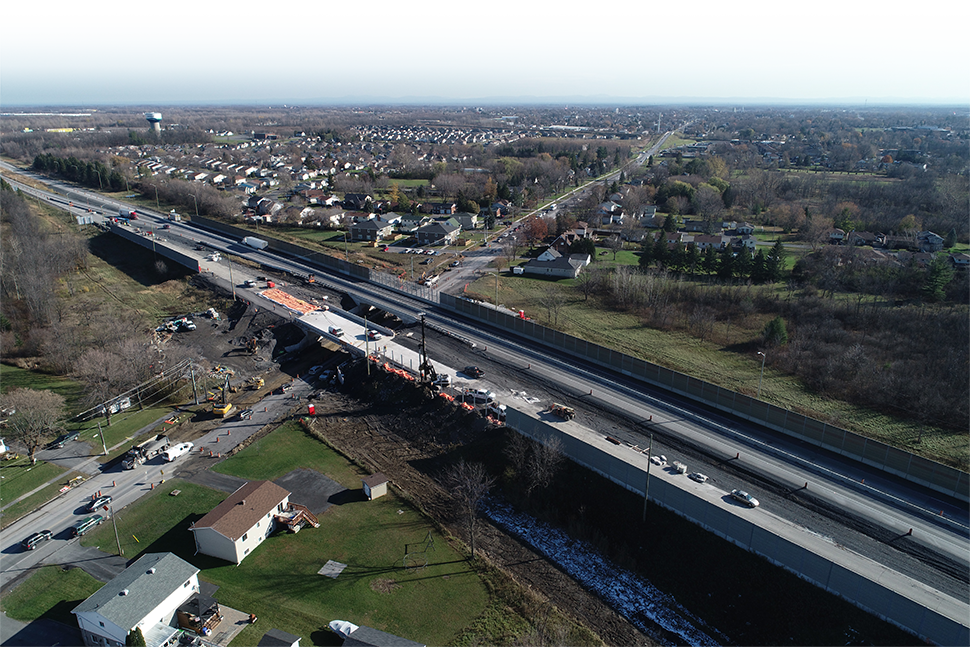
Expanding Highway 7 in York-Durham Region
The government is planning to expand Highway 7 from two to four lanes from west of Reesor Road in Markham, east to Brock Road in Pickering, to support the development of the City of Pickering’s Innovation Corridor. This will ensure Highway 7 is a continuous four-lane highway, supporting the movement of goods and people in the region.
Building the New Highway 7 from Kitchener to Guelph
The government is advancing the project with activities that include replacement of the Frederick Street Bridge in Kitchener, environmental fieldwork, and other engineering work to support construction on the remainder of the corridor. Contractors were invited to submit proposals for the replacement of the Frederick Street Bridge in February 2024.
The final phase of construction for the new Highway 7 between Kitchener and Guelph will provide relief to the busy Highway 401 and connect the fast‐growing urban centres of Kitchener, Waterloo and Guelph.
Connecting Highway 401 to Lauzon Parkway in Windsor
The government is supporting the City of Windsor by initiating a procurement for an environmental assessment and design of a new interchange connecting Highway 401 to Lauzon Parkway. The interchange will support increased opportunities for trade and better access to the Windsor-Detroit border.
Building Highway 413
By 2051, the population in the Greater Golden Horseshoe is expected to reach nearly 15 million, growing by approximately one million new residents every five years. There is a pressing need for new highways to prepare for this growth and to help alleviate gridlock in what is already one of the busiest corridors in North America.
Ontario continues to move ahead with Highway 413, a new 52-kilometre (km) 400-series highway to better connect the corridor across Halton, Peel and York Regions. The highway will extend from Highway 400 in the east to the Highway 401/407 Express Toll Route (ETR) Interchange in the west and include extensions to Highway 410 and Highway 427.
During construction, Highway 413 is expected to support up to 3,500 jobs each year and generate up to $350 million in annual real GDP. Once completed, Highway 413 will save drivers up to 30 minutes each way on their commute and keep goods and the economy moving. Upon completion, more than 300,000 trips will be taken on the highway every day.
The Highway 413 project is currently in Stage 2 of the Environmental Assessment, which includes refining the route, determining interchange and crossing road locations, and completing preliminary design for the proposed new transportation corridor. Significant data collection, fieldwork and analysis is continuing. In addition, several community and advisory group meetings have been held, as well as engagements and consultations with Indigenous communities.
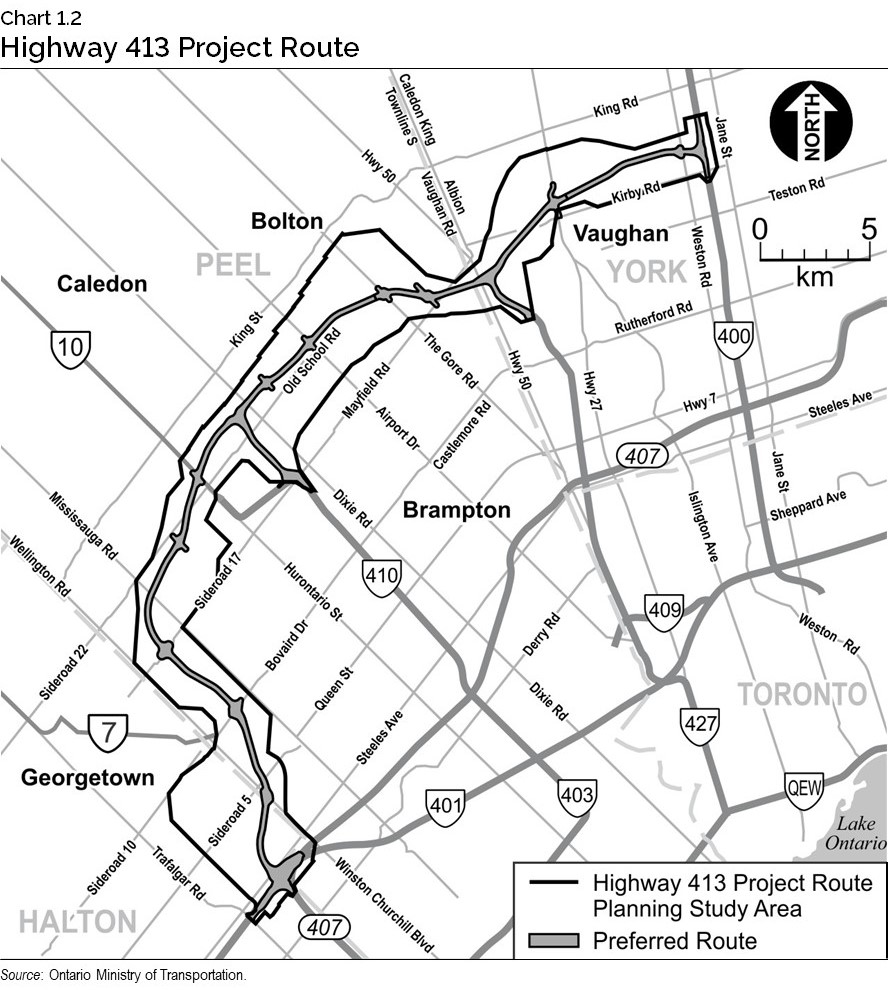
Getting the Bradford Bypass Built
Ontario is helping prepare York Region and Simcoe County for rapid population growth over the next 10 years by building the Bradford Bypass, a new four-lane highway that would relieve congestion on existing east-west local roads and provide a northern freeway connection between Highway 400 and Highway 404.
In November 2022, construction began with an Early Works contract to build a new bridge at Simcoe County Road 4. In December 2023, the government initiated procurement activities to advance the development of the West Contract of the Bradford Bypass for the section from Highway 400 to County Road 4. This includes procuring services to design the route. This procurement is expected to be completed by late spring 2024.
Once complete, the Bradford Bypass will save drivers an estimated 35 minutes in travel time. During construction, the project is expected to create up to 2,200 jobs per year and contribute up to $286 million to GDP between 2024 and 2030.
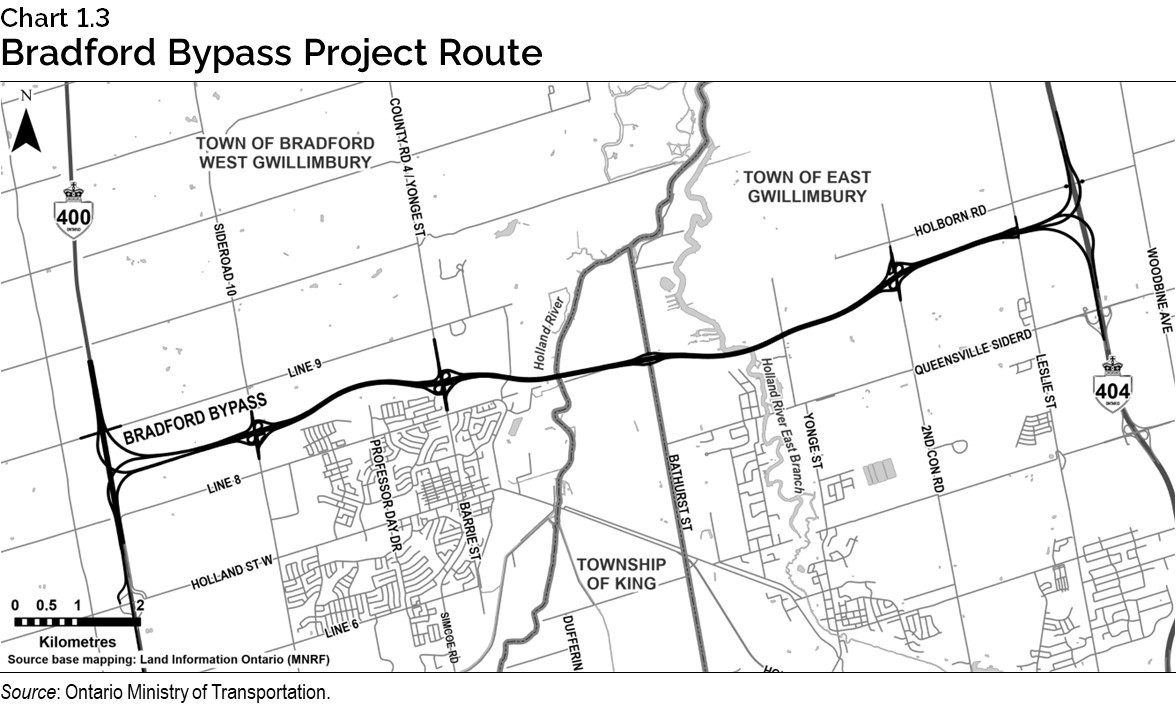
Expanding Highway 401
The Highway 401 corridor in Eastern Ontario is an important economic link between Ontario, Eastern Canada and the United States. It carries about 10,000 trucks with commodities valued at up to $380 million per day. The government is continuing work to widen Highway 401 easterly from Brock Road in Pickering, as well as replacing bridges in Port Hope, helping tens of thousands of drivers per day get to work and home faster, as well as get goods to market sooner.
This builds on the previous work to improve the Highway 401 corridor, including the recent completion of additional lanes in Mississauga and Milton.
Building Highways for Northern Ontario
The government is investing in highways in the North to improve road safety and unlock economic opportunities. Projects include:
- Supporting the construction and repair of municipal roads and bridges that connect to provincial highways through communities, including the reconstruction of Highway 101 through Timmins;
- Widening Highway 17 from Kenora to the Manitoba border;
- Resurfacing Highway 144 from north of Highway 560 northerly to Highway 661, near Gogama;
- Continuing to widen Highway 69 from two to four lanes, from Parry Sound to Sudbury;
- Expanding Highway 11/17 between Coughlin Road and Highway 582 (east junction) west of Red Rock;
- Widening Highway 11/17 between Thunder Bay and Nipigon; and
- Proceeding with the design and environmental assessment work for a 2+1 highway pilot in Northern Ontario, for two locations on Highway 11 north of North Bay. A 2+1 highway is a three‑lane highway with a centre passing lane that changes direction approximately every two to five kilometres.
Expanding and Improving Roads, Highways and Bridges Across Ontario
The government is investing $27.4 billion over the next 10 years to connect communities, fight gridlock and keep goods and people moving across the province. The Ontario highways program includes more than 650 expansion and rehabilitation projects that are either underway or planned over the next four years.
In 2024–25 alone, Ontario is investing $3.9 billion towards projects that will expand and rehabilitate provincial highways and bridges.
The government is building capacity and enhancing road safety for travellers by:
- Moving forward with the Queen Elizabeth Way (QEW) Garden City Skyway Bridge Twinning project, which includes construction of a new twin bridge on the QEW over the Welland Canal;
- Widening Highway 404 from Highway 407 to Major Mackenzie Drive, Markham, for high-occupancy vehicle (HOV) lanes;
- Widening Highway 3 from two to four lanes between Essex and Leamington;
- Replacing the Little Current Swing Bridge on Highway 6 in the Town of Northeastern Manitoulin and the Islands;
- Rehabilitating Highway 403 between Highway 401 and West Quarter Townline Road in Brant and Oxford Counties;
- Repairing bridges and culverts on Highway 28 in Renfrew County;
- Constructing a new interchange on Highway 6 in Wellington County as part of advance work for the Morriston Bypass;
- Rehabilitating the Bay of Quinte Skyway Bridge;
- Replacing bridges on Highway 417 in Ottawa; and
- Widening Highway 3 and Highway 4 to support growth and economic development in St. Thomas.
Table 1.2
Recently Completed Highway Projects
Northern
- Highway 11/17: Expansion from two to four lanes from west of CPR Overhead at Ouimet, westerly to Dorion East Loop Road.
- Highway 11/17: Highway expansion, including construction of a new Commercial Vehicle Inspection Facility from 7.3 km east of Highway 527, easterly for 3.3 km.
- Highway 17: Resurfacing, paved shoulders and other improvements from Sudbury easterly to Kukagami Road, west of Markstay.
- Highway 101: Resurfacing for 21 km from west of Little Star Lake Road to Nat River Bridge, east of Foleyet.
Eastern
- Highway 17: New interchange at Calabogie Road, Renfrew County.
- Highway 401: Replacement of Halleck’s Road Bridge, United Counties of Leeds and Grenville, west of Brockville (allowing for future expansion of Highway 401).
- Highway 7: Paving and drainage improvements, from Omemee westerly to Slanted Road, Kawartha Lakes.
Southwestern
- Highway 21: Rehabilitation from Bruce Road 10 to Springmount.
- Highway 402: Rehabilitation from Longwoods Road to Colonel Talbot Road, Middlesex County.
- Highway 402: Resurfacing and culvert replacement from Colonel Talbot Road to Highway 401, London.
- Highway 24: Resurfacing and reconstruction from Powerline Road to Glen Morris Road, County of Brant.
- Highway 401: Widening from Highway 8 to Townline Road, Cambridge.
Central
- Highway 400: Bridge and pavement rehabilitation from Steeles Avenue to Langstaff Road, Vaughan.
- Highway 35: Bridge and pavement rehabilitations from Main Street north junction (Durham Road 17) to Highway 115, Clarington.
- Highway 11: Bridge replacement, West Street, Orillia.
- Highway 89: Pavement rehabilitation, culvert replacement, and other improvements from Industrial Parkway to west of Simcoe Road 50, Adjala-Tosorontio, Simcoe.
Source: Ontario Ministry of Transportation.
Building Transit
Delivering on Ontario’s Plan to Build with public transit projects is vital to supporting the province’s economy, alleviating gridlock, and connecting more people to jobs and housing.
Building More Frequent and Connected GO Transit Services
To better connect growing communities across the Greater Golden Horseshoe and Southwestern Ontario, the government is continuing to expand and build better GO train and GO bus services to make it easier and faster for people to get where they need to.
Ontario continues to invest in service and capacity improvements across the core network to bring two-way, all-day GO Transit service with faster trains, more stations and better connections.
- Kitchener GO Line: To enable two-way, all-day service on the Kitchener Line, improvements are being made to stations and the railway corridor. In Guelph, installation of the steel structure for the new south platform canopy was completed in August 2023, and work on the new train platform will be completed in 2024.
- Bowmanville GO Rail Extension: In June 2023, the government awarded a contract to advance the planning to extend GO rail service east of Oshawa into Bowmanville, which includes new tracks and signals, seven new bridges and at-grade crossing upgrades.
- Niagara GO Rail: In May 2023, the government increased GO train service between Union Station and the Niagara Region, with more express service between Hamilton, Burlington and Toronto. Year-round daily trips will not only reduce travel times for commuters but help to promote tourism in the Niagara Region.
- Bloor GO Station: In August 2023, the government awarded a contract for the construction of a pedestrian tunnel connecting the Bloor GO/Union Pearson (UP) Express Station and the TTC’s Dundas West Station. The Bloor GO/UP Express Station/TTC Connection will encourage travellers to choose to combine GO Transit or UP Express trips with TTC subway, streetcar or bus services, and support the growth of a more interconnected regional rapid transit network.
- Bramalea GO Station: The brand new accessible station, parking garage and bus loop will provide better access to GO Transit and Brampton Transit services. These improvements at the Bramalea GO Station will support future two-way, all-day GO train service along the Kitchener Line and connect more people to transit, jobs and housing across the Greater Golden Horseshoe.
- Aurora GO Station: The government is making critical infrastructure upgrades to the Aurora GO Station, which will provide commuters with better service, more transit connections and future two-way, all-day service between the Aurora GO Station and Union Station in Toronto. In August 2023, construction began on improvements that will include a new second platform and track, a new pedestrian tunnel with elevators, additional parking spaces, as well as rail signal upgrades.
- Stouffville GO Line: In October 2023, the government completed major infrastructure improvements at the new Old Elm GO Station and added two additional GO train trips along the Stouffville Line, which will increase safety and accessibility for customers, while supporting future two-way, all-day train service.
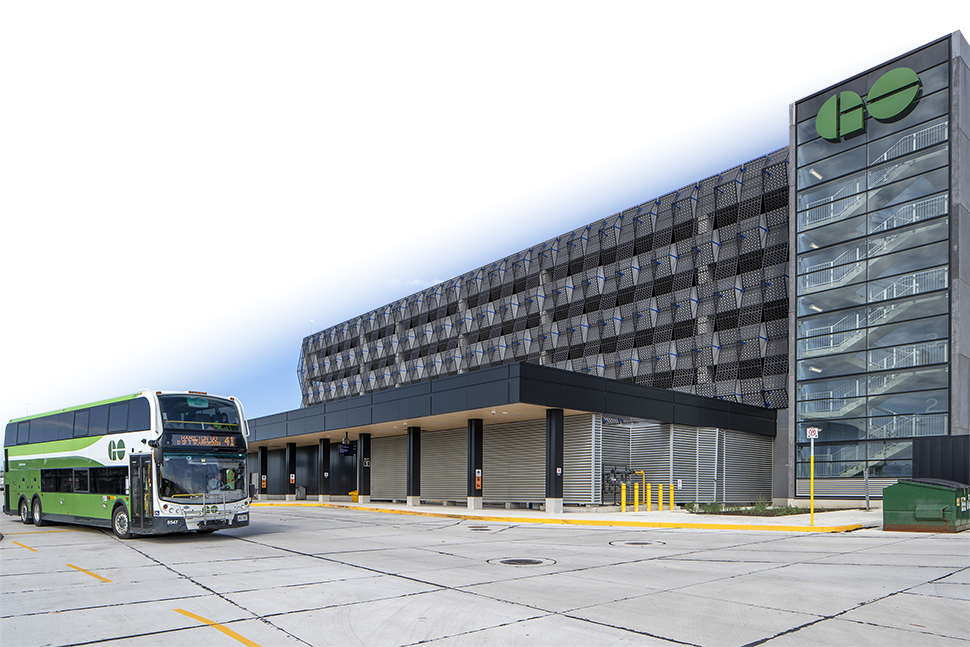
Building Subways
Work is underway on all four of Ontario’s priority subway projects. The government is closer to providing better travel options, alleviating gridlock on the roads and creating thousands of good, local jobs.
The combined subway projects will support more than 16,000 jobs annually during construction over the next decade. Shovels are in the ground and recent milestones include:
- Ontario Line: The government received responses to its RFPs for the Pape Tunnel and Underground Stations and the Elevated Guideway and Stations contracts. Metrolinx and Infrastructure Ontario (IO) will enter into a development phase with the preferred proponent for each contract in 2024. Work is also underway in the Lakeshore East rail corridor, bringing transit upgrades including new rail bridges, retaining walls and noise walls to neighbourhoods surrounding the future sites of East Harbour, Riverside-Leslieville and Gerrard Stations. The project will provide significant relief from crowding throughout the existing transit network with 388,000 daily boardings expected and will reduce traffic congestion with 28,000 fewer cars on the road expected daily.
- Three-Stop Scarborough Subway Extension: In November 2022, the government selected a development partner for the Stations, Rail and Systems Contract. This contract includes design and construction of three new underground stations and bus terminals at each station. Work to build the extraction shaft for the tunnel boring machine began in October 2023. The project is expected to have 105,000 daily boardings and provide transit access within walking distance to 38,000 more people.
- Yonge North Subway Extension: In December 2023, the government issued an RFP for the Advance Tunnel Contract that includes work to design, build and finance the construction of tunnels. Early upgrade work at Finch Station, where the Yonge North Subway Extension will connect with existing Line 1 subway service, is now substantially complete. The upgrades set the stage for major construction of the subway extension to Richmond Hill and Markham.
- Eglinton Crosstown West Extension: As of February 2024, tunnelling is over 80 per cent complete. Contracts were awarded for the elevated guideway portion in December 2023 and the Advance Tunnel 2 project in February 2024.
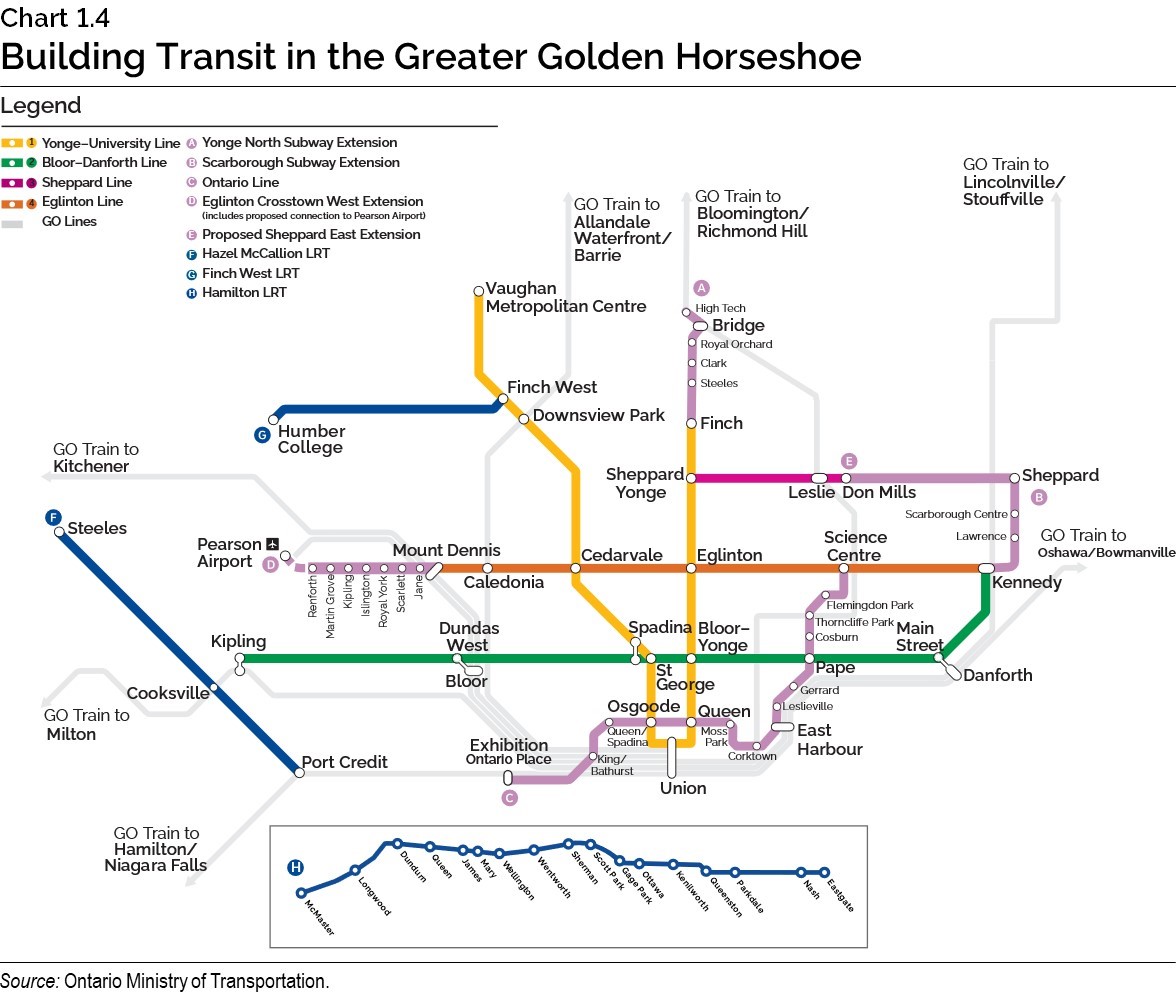
Building and Expanding Light Rail Transit
The government is bringing fast, reliable transit projects to help reduce travel times and create more transit options, including:
- Finch West Light Rail Transit (LRT): This LRT from Humber College to Finch West Station will give those in Northwest Toronto a transit system that offers more choices to travel, cuts down on travel time and increases transit reliability. The project has reached a number of important milestones, including completing the construction of the guideway and maintenance and storage facility and receipt of all 18 light rail vehicles. The project is now undergoing testing and commissioning in preparation for service.
- Eglinton Crosstown LRT: The last remaining lane restrictions for construction of the Eglinton Crosstown LRT have been lifted. Platform work is also largely complete. Rigorous testing is currently underway across various systems.
- Proposed Sheppard East Extension: The government is currently studying options and seeking community input to extend rapid transit east along Sheppard Avenue, which would improve transit connections in Toronto’s north end and make it easier and faster for people to get around Toronto and the LRT.
- Hamilton LRT: Due diligence work is currently underway related to matters such as subsurface investigations. In addition, engagement with Indigenous communities is also ongoing.
Building Transit-Oriented Communities
The Transit‐Oriented Communities Program is part of the government’s plan to build vibrant, complete, mixed‐use communities at or around transit stations. Transit‐Oriented Communities will help increase transit ridership, create sustainable communities and build more homes, including more affordable housing, around GO Transit, LRT and subways. While Ontario works to help build 1.5 million homes by 2031, work is already underway to deliver on the Transit‐Oriented Communities at 12 future stations along the new Ontario Line, Scarborough Subway Extension, and the Yonge North Subway Extension, creating over 79,000 new jobs and approximately 54,000 new residential units.
The government also passed the GO Transit Station Funding Act, 2023, to provide a new, voluntary funding tool for municipalities. This tool, called the Station Contribution Fee, could be used by municipalities to fund the design and construction of new GO Transit stations and recover costs over time as new development occurs around these future stations, encouraging new housing and mixed-used communities.
As part of the new deal with the City of Toronto, the municipality agreed to advance Transit-Oriented Communities by prioritizing approvals and finalizing agreements for the development of East Harbour, along with cooperation and collaboration from the City of Toronto on a proposal for a mixed-use Transit-Oriented Community at the future Woodbine GO Station.
Bringing Back the Northlander

Ontario is delivering on its promise to restore passenger rail service to Northern Ontario as the original Northlander service was cancelled in 2012. The Northlander train service will provide a safe and reliable transportation option for Northern communities and will run from Toronto to Timmins with a rail connection to Cochrane.
As part of this commitment, Ontario has purchased three new trainsets for the reinstated service. Moving forward, implementation activities include detailed design and engineering, environmental assessment, Indigenous and municipal engagement and consultation, and procurement, with construction of station and track improvements expected to begin in 2024.
The Northlander train will provide improved access to essential services such as health care and education, while supporting economic prosperity and tourism in the region, as well as strengthening the connection between the North and the South.
Supporting Ontario’s Shortline Rail System
A well-functioning supply chain is critical for Ontario’s economy. Ontario has an extensive network of railways including both larger national railways and several shortline railway systems. Shortline railways typically run shorter distances than the larger national railways and are often used to move goods between shippers and the main railway lines, providing critical “first and last mile” service to rail customers.
Ontario is committed to exploring ways to support shortline rail, which plays an integral role in providing safe and efficient transport of goods and people throughout the province.
In January 2023, the provincial government partnered with the federal government to announce an investment to support the rehabilitation of key rail infrastructure for the Huron Central Railway, which operates freight service between Sault Ste. Marie and Sudbury.
Launching the Ontario Transit Investment Fund
The government is launching the Ontario Transit Investment Fund to provide annual funding of $5 million to deliver local and intercommunity transportation projects in unserved and underserved areas in Ontario, particularly in rural areas. The Ontario Transit Investment Fund builds on the Community Transportation Grant Program and will include an ongoing application-based intake with expanded eligibility that includes municipalities, Indigenous communities and non-profit organizations.
Footnotes
[1] Bank of Canada, “Decomposing Canada’s Market Shares: An Update,” (August 2018), https://www.bankofcanada.ca/2018/08/staff-analytical-note-2018-26/
[2] Ontario Creates, “2022 Film and Television Production Statistics,” https://www.ontariocreates.ca/assets/images/research/Statistics/Eng/2022-Film-and-Television-Production-Statistics-Backgrounder-final.pdf
[3] “Ontario High-Speed Internet Projects and Availability — Provincial Projects Download,” https://www.ontario.ca/page/ontario-connects-making-high-speed-internet-accessible-in-every-community
Chart Descriptions
Chart 1.1: Supporting Ontario Businesses
This bar chart illustrates that Ontario businesses are expected to receive an estimated $8.0 billion in savings and support in 2024. This includes combined support from lowering payroll costs ($3,340 million), providing electricity and other price relief ($1,730 million), providing income and property tax relief ($1,025 million), and cancelling the cap-and-trade carbon tax ($1,895 million).
Notes: Lowering payroll costs includes supporting Workplace Safety and Insurance Board (WSIB) premium reductions, increasing the Employer Health Tax (EHT) exemption to $1 million which started in 2020, and changing the minimum wage. Providing electricity and other price relief represents lowering electricity prices through the Comprehensive Electricity Plan; reducing Liquor Control Board of Ontario (LCBO) wholesale prices for bars, restaurants and other eligible licence holders; and the direct savings to businesses from extending the 5.7 cent per litre cut to the gas tax and the 5.3 cent per litre cut to the fuel tax until December 31, 2024. Providing income and property tax relief includes reducing Ontario’s small business corporate income tax rate to 3.2 per cent and expanding access to this preferential rate; allowing businesses to accelerate writeoffs of capital investments for income tax purposes; implementing the Regional Opportunities Investment Tax Credit; Implementing the Ontario Made Manufacturing Investment Tax Credit; lowering high Business Education Tax (BET) rates; and not paralleling the federal tax increase on some small businesses earning passive investment income. Figures are rounded to the nearest five million.
Source: Ontario Ministry of Finance.
Chart 1.2: Highway 413 Project Route
This map illustrates the preferred route of Highway 413, a 52-kilometre highway and transportation corridor that will extend from Highway 400 (between Kirby Road and King-Vaughan Road) in the east to the Highway 401/407 Express Toll Route (ETR) interchange area in the west, connecting the regions of York, Peel and Halton.
Source: Ontario Ministry of Transportation.
Chart 1.3: Bradford Bypass Project Route
This map illustrates the route of the Bradford Bypass, a 16.3-kilometre controlled-access freeway connecting Highway 400 and Highway 404 in the County of Simcoe and Regional Municipality of York. The highway will extend from Highway 400 between Eighth Line and Ninth Line in Bradford West Gwillimbury, cross a small portion of King Township, and connect to Highway 404 between Queensville Sideroad and Holborn Road in East Gwillimbury.
Source: Ontario Ministry of Transportation.
Chart 1.4: Building Transit in the Greater Golden Horseshoe
This map shows various transit lines in the Greater Golden Horseshoe highlighting the following:
Yonge-University Line
- Provides two-way subway service from Finch Station to Vaughan Metropolitan Centre Station connecting North York and Vaughan.
- Key stops from east to west include Sheppard Yonge, Eglinton, Bloor-Yonge, Queen, Union Station, St George, Spadina, Cedarvale/Eglinton West, Downsview Park and Finch West.
Bloor-Danforth Line
- Provides two-way subway service from Kennedy Station to Kipling Station connecting Scarborough to Etobicoke.
- Key stops from east to west include Main, Pape, Bloor-Yonge, St George, Spadina and Dundas West.
Sheppard Line
- Provides two-way subway service from Don Mills Station to Sheppard Yonge Station in North York with a key stop at Leslie Station.
Eglinton Crosstown Line
- Provides two-way light rail service from Kennedy Station to Mount Dennis Station along Eglinton Avenue.
- Key stops from east to west include Science Centre, Eglinton, Cedarvale and Caledonia.
GO Lines
- The Barrie Line provides GO train service from Union Station in downtown Toronto to Allandale Waterfront Station in Barrie.
- The Kitchener Line provides GO train service from Union Station in downtown Toronto to Kitchener.
- The Lakeshore East Line provides GO train service from Union Station in downtown Toronto to Oshawa/Bowmanville.
- The Lakeshore West Line provides GO train service from Union Station in downtown Toronto to both Hamilton and Niagara Falls.
- The Milton Line provides GO train service from Union Station in downtown Toronto to Milton.
- The Richmond Hill Line provides GO train service from Union Station in downtown Toronto to Bloomington Station in Richmond Hill.
- The Stouffville Line provides GO train service from Union Station in downtown Toronto to Old Elm Station in Stouffville.
Yonge North Subway Extension
- Will provide additional two-way subway service north of Finch Station with five new additional stations — Steeles, Clark, Royal Orchard, Bridge and High Tech.
Scarborough Subway Extension
- Will provide additional two-way subway service northeast of Kennedy Station with three new stations — Lawrence, Scarborough Centre and Sheppard.
Ontario Line
- Will provide additional two-way subway service from Eglinton Avenue and Don Mills Road to Exhibition Place through downtown Toronto.
- The new line will feature 15 stops including Flemingdon Park, Thorncliffe Park, Cosburn, Pape, Gerrard, Leslieville, East Harbour, Corktown, Moss Park, Queen, Osgoode, Queen/Spadina and King/Bathurst.
Eglinton Crosstown West Extension
- Will provide additional light rail service west of the future Mount Dennis station with seven new proposed stops at Jane, Scarlett, Royal York, Islington, Kipling, Martin Grove and Renforth.
- Includes proposed connection to the Toronto Pearson International Airport.
Proposed Sheppard East Extension
- Would provide additional rapid transit service from the existing Sheppard Line east of Don Mills Station to the new Sheppard Station in Scarborough.
Hazel McCallion Light Rail Transit
- Will provide new light rail service in Peel Region connecting Port Credit Station in Mississauga to Steeles Station in Brampton along Hurontario Street.
Finch West Light Rail Transit
- Will provide new light rail service connecting Finch West Station on the Yonge-University Line to Humber College.
Hamilton Light Rail Transit
- Will provide new light rail service connecting Eastgate Square to McMaster University through downtown Hamilton.
- The new line will feature 17 stops including Nash, Parkdale, Queenston, Kenilworth, Ottawa, Gage Park, Scott Park, Sherman, Wentworth, Wellington, Mary, James, Queen, Dundurn and Longwood.
Source: Ontario Ministry of Transportation.